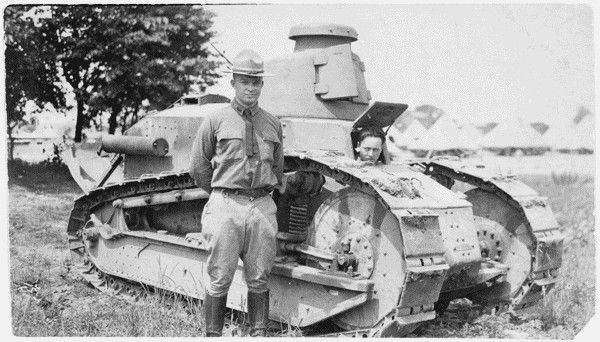Lieutenant Colonel Dwight D. Eisenhower
1919
Add to Favorites:
Add all page(s) of this document to activity:

This is a photograph of Lieutenant Colonel Dwight D. Eisenhower standing in front of a tank at Fort Meade, Maryland. Eisenhower, a 28-year-old officer grown bored with his peacetime posting at Fort Meade, was one of the army observers on a 1919 Transcontinental Motor Convoy that toured the country along the Lincoln Highway, from Washington, DC, to San Francisco, California.
The U.S. War Department had wanted to know if the country’s roads could handle long-distance emergency movements of motorized army units across the nation, since vehicles had played a vital role in World War I. As a test, the convoy of 80 military vehicles and 280 officers and enlisted personnel set out for California from Washington, DC, on July 7, 1919.
In the manner of the wilderness scouts of the 19th century, army personnel — mounting Harley-Davidsons instead of horses — ran ahead of the convoy to check out the conditions that lay just ahead. The vehicles broke down; got stuck in dust, quicksand, and mud; and sank when roads and bridges collapsed.
After 62 days, the convoy reached San Francisco. It had covered 3,251 miles, averaging 58 miles a day at an average speed of 6 miles an hour. The official report of the War Department, chronicling the 230 motor accidents of the convoy, concluded that the existing roads in the United States were "absolutely incapable of meeting the present day traffic requirements."
The experience, which Eisenhower later described as "a genuine adventure" left a lifelong impression on him. When President 37 years later, he signed into law the Federal-Aid Highway Act of 1956, funding the National System of Interstate and Defense Highways which established more than 41,000 miles of superhighway.
The U.S. War Department had wanted to know if the country’s roads could handle long-distance emergency movements of motorized army units across the nation, since vehicles had played a vital role in World War I. As a test, the convoy of 80 military vehicles and 280 officers and enlisted personnel set out for California from Washington, DC, on July 7, 1919.
In the manner of the wilderness scouts of the 19th century, army personnel — mounting Harley-Davidsons instead of horses — ran ahead of the convoy to check out the conditions that lay just ahead. The vehicles broke down; got stuck in dust, quicksand, and mud; and sank when roads and bridges collapsed.
After 62 days, the convoy reached San Francisco. It had covered 3,251 miles, averaging 58 miles a day at an average speed of 6 miles an hour. The official report of the War Department, chronicling the 230 motor accidents of the convoy, concluded that the existing roads in the United States were "absolutely incapable of meeting the present day traffic requirements."
The experience, which Eisenhower later described as "a genuine adventure" left a lifelong impression on him. When President 37 years later, he signed into law the Federal-Aid Highway Act of 1956, funding the National System of Interstate and Defense Highways which established more than 41,000 miles of superhighway.
This primary source comes from the Collection DDE-1038: Still Photograph Collection.
National Archives Identifier: 876971
Full Citation: Photograph 62-286-2; Photograph of Lieutenant Colonel Dwight D. Eisenhower; 1919; Numerical Photographs, 1962 - ca. 1979; Collection DDE-1038: Still Photograph Collection; Dwight D. Eisenhower Library, Abilene, KS. [Online Version, https://docsteach.org/documents/document/lieutenant-colonel-eisenhower, April 19, 2024]Activities that use this document
- The Life of Dwight D. Eisenhower
Created by the National Archives Education Team
Rights: Public Domain, Free of Known Copyright Restrictions. Learn more on our privacy and legal page.



